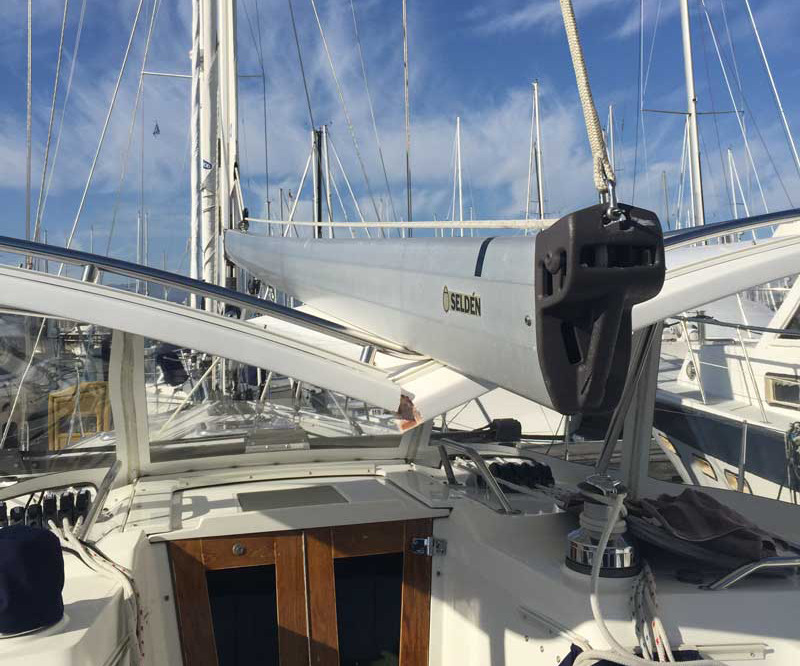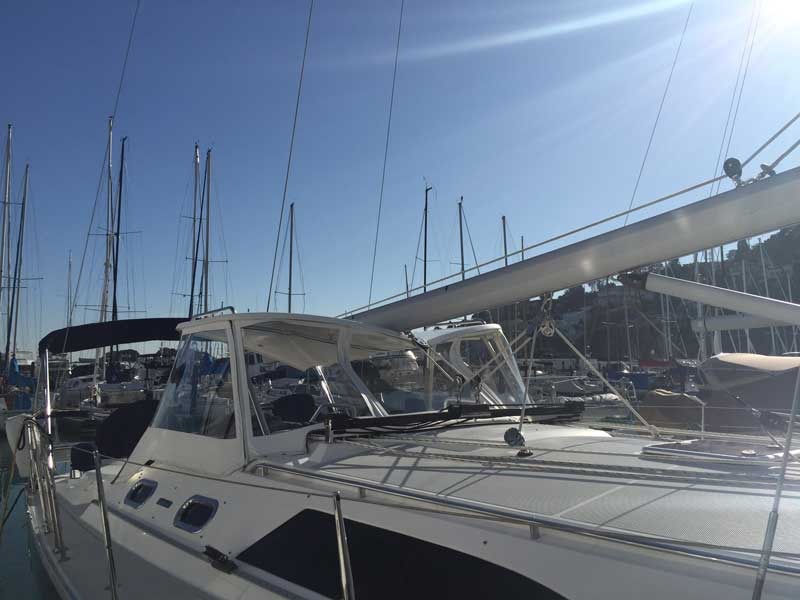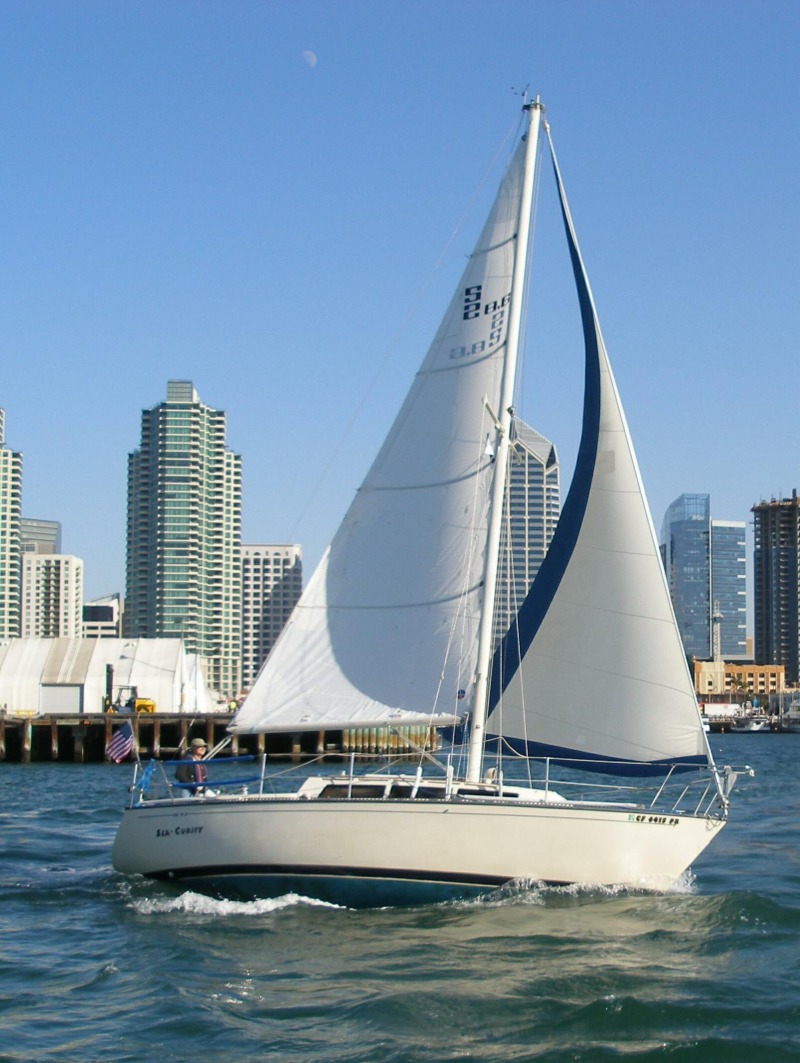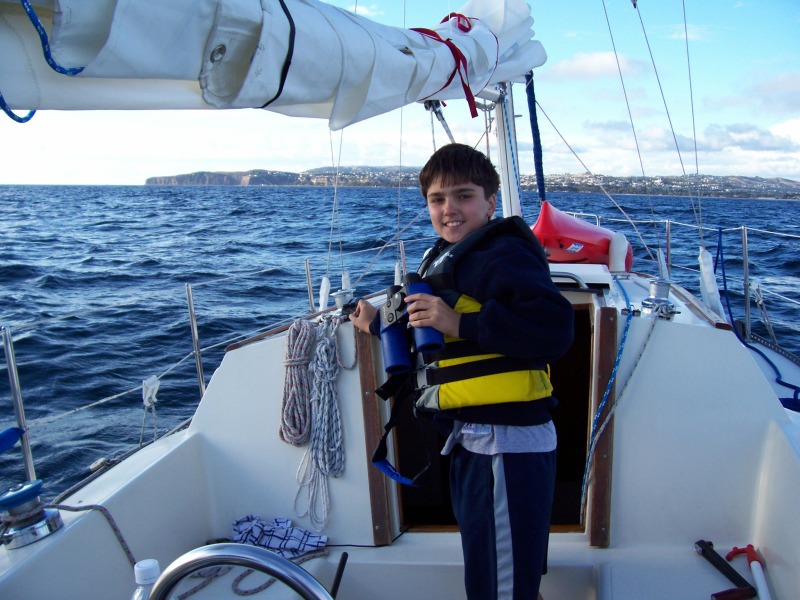
Crushing Issue
Here’s a new one for us. On Monday, December 22, Greg Quilici received a message from Sausalito Yacht Harbor that his boom had fallen through the hard-top dodger of his Catalina 445 Blue Seaclusion. Understandably shocked and curious as to how a boom could destroy a hard dodger, Greg drove to the harbor to discover the boom had not fallen, but instead, the electric mainsheet winch had malfunctioned. It had turned itself on and proceeded to grind the mainsheet in until the boom was pulled down! No one was onboard at the time and the winch only stopped after overheating the thermal circuit breaker. "Having never heard of malfunctioning winches, it never occurred to me to cut the power off when leaving, particularly since the circuit breaker is located under the chart table," stated Greg.

Greg wrote, "You don’t really appreciate the power of these winches until you witness the destruction or bodily harm they could cause. I would caution everyone with an electric winch not to leave a sheet made up on it or cut off the power when departing."

The incident seemed odd, so we asked Greg if he had any other insights and, amazingly he responded: "I’ve come to find out that my neighbor at Sausalito Yacht Harbor, with a 2008 Catalina 42 and a hard dodger, had the exact thing happen 11 months ago. His winch malfunctioned with no one onboard and destroyed his dodger."
We got a little suspicious and asked Greg if he thought a vandal could be running around pushing winch buttons. Greg replied, "I thought the same thing, but there was a witness working on a boat two slips away who heard the dodger collapse. He told me he came over and the winch was running with the mainsheet slipping around the tailer. Apparently it was making a loud shrieking sound — like the old 12-meter winches."
We haven’t heard of this happening before, but would be curious to know if anyone has had similar issues. Let us know. The same problem in the same yacht harbor is highly coincidental. Either way, we think switches are provided everywhere for a reason. If they don’t need to be turned on, make sure they’re off!
The Boys of Sausalito Built El Toros
A member of the Facebook group Sausalito Children has been posting scans of the Richardson Bay School 1967 yearbook. We were particularly intrigued by page 34. As you can clearly see, the school, which would later be renamed Martin Luther King Jr., was segregated. Not by race, but by gender.

The girls learned cooking, sewing and "good grooming" in Home Ec, while the boys went to Industrial Arts and learned the use of hand tools, making projects "from sea-horses to El-Toro sailboats."
We wonder if some of those same wooden El Toros were among those used a few years later in nearby Tamalpais High School’s summer school sailing class, and perhaps sailed by some of those same kids (girls included).
Alert: Change in Mexico Tourist Visas
We just got off the phone with Fito Espinosa, harbormaster at Marina Coral in Ensenada, who was bringing us up to date with an important clarification in the procedure for acquiring a tourist visa for cruisers entering Mexico. In the past, cruisers have been able to get a tourist visa for everyone on their crew list through the online system, then saving the receipt to present to immigration at the first point of entry. Upon review by Mexican government officials, this procedure is no longer going to be available to cruisers entering Mexico, and will only be available for those entering Mexican waters and not going ashore, i.e. fishermen and others who might sail from San Diego into Mexican waters and return.
The revised procedure is intended to have cruisers check in at their first port of entry with immigration and then the port captain’s office. You will need to pay for the tourist visas for each member of the crew at immigration — a receipt from prepaid visas obtained online will no longer suffice. If you’re already in Mexico and have your tourist visas acquired with the receipt from prepayment made earlier, you’re fine. If you’ve already paid for your visas online, haven’t yet entered Mexico and are hoping a grace period will be allowed, it’s not clear what kind of buffer will be allowed. The worst case scenario is likely that you’d just have to pay the 500-peso fee again.
Your first port of entry could be Ensenada or Cabo, or wherever you sail in with both an immigration office and a port captain. You can see the list here (in Spanish) though not all are staffed to handle recreational cruisers or convenient to reach. If you’re relaxed and just cruising it might be easiest to enjoy some time in Ensenada and take care of the paperwork there, as both offices are located in the same building.
As always, the only constant is change. This is a recently announced clarification of how the policy is currently being interpreted and you should proceed accordingly. We’ll let you know as further clarifications arise.
The Training Boat, Part 2
We bring you part 2 of Lee Johnson’s The Training Boat. After doing a series of sail training courses in San Diego, Johnson — who resides in Arizona — started to consider buying his own boat. "I knew that it would take a lot more experience in short and middle-distance cruising before the purchase of a bluewater boat would make sense," Johnson wrote on Monday. "After all, I still didn’t know if owning a boat in another state would prove viable for me at all . . ."
These circumstances and thoughts not only impelled me to the purchase of a sailboat, they also dictated the criteria for that boat. She had to be seaworthy enough to get me to Catalina and beyond, safely and comfortably. She needed to be small enough for me to singlehand — because I knew I would be sailing without crew much of the time. And she had to be cheap enough that if it didn’t work out I could quickly sell or simply donate her to charity. Naturally, I thought I was looking for a Catalina 30.

I looked at a few Catalina 30s, and then saw an ad for something different and rather intriguing: a 28-ft sloop built in Holland, Michigan, by S-2 Yachts, Inc. Called a Model 8.6 for her length on deck in meters, the sailing vessel Sea-Curity looked like a good prospect. Wheel steering, inboard diesel, enclosed head, with decent galley and accommodations, and pleasing, modern lines for a mid-80’s boat. Most of all, research suggested that this was a solid, seaworthy vessel, built to withstand the rigors of sailing on the Great Lakes, not just the mild conditions typical in Southern California.
I called the brokerage, and Phil [Kinnison, a yacht broker] picked up the assignment to show me the boat. I would have him show me other boats, but Sea-Curity seemed to both of us to best suit my purposes — to sail the coastal waters and see if, indeed, I was destined to someday cross an ocean or two. And so, less than six months after my sail training excursion, I closed on the purchase of that boat.
By the time of my lunch with Phil a year later, the boat-owning thing was working out quite nicely. And it would continue to do so. I managed to visit Sea-Curity (aka the ‘8000-Pound Girlfriend’) about once a month; sometimes just for a daysail, sometimes without leaving the dock. But there were also multiple-day excursions several times a year. San Diego Bay to Oceanside, for a guest slip there for the night, became a favorite. The first trip to Avalon, with my 10-year-old son aboard, would be the first of many Catalina adventures. When conditions didn’t favor venturing offshore, we took mini-excursions from Shelter Island to Chula Vista or Glorietta Bay, all within the protected waters of San Diego Bay.

As the years went on, I came to know that these adventures were my preparation for longer travels on the ocean one day. While Sea-Curity was not a bluewater boat herself, she helped me answer the question of whether I would someday move on to such a vessel. Sea-Curity was my training boat, and she successfully completed her mission. Not long ago I replaced her with the sailing vessel Morning Star, a well-found Valiant 32, in great condition and already equipped for long-distance cruising.
My lunch with Phil Kinnison was more than ten years ago. Despite his warning that boat ownership would f—k up the best parts of my life — namely home, family and career — the facets of my life remained intact. But having now logged several multi-day excursions on Morning Star, the prospect of sailing over the horizon seems to be moving from the hypothetical to the imperative. Maybe Phil wasn’t really wrong with his sardonic prediction. Maybe he was just off by one boat.
